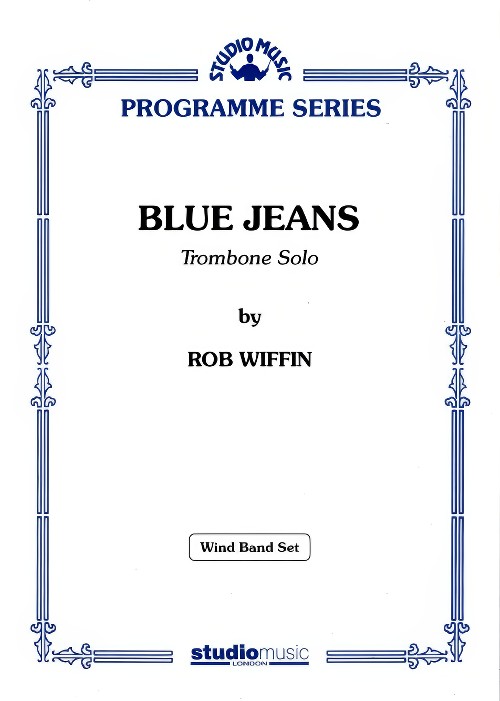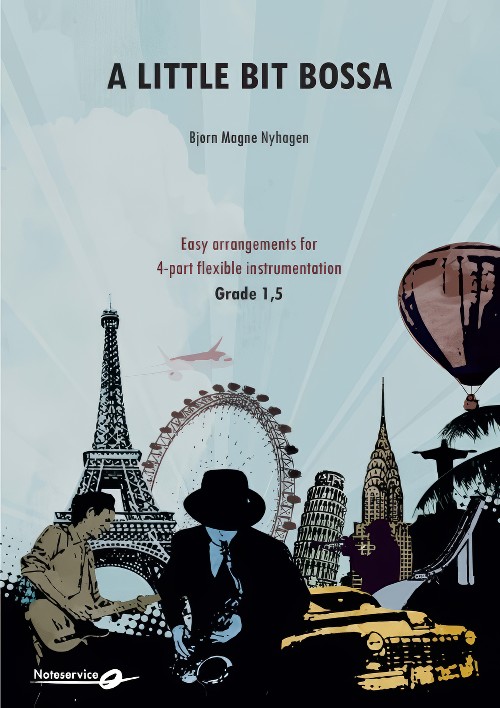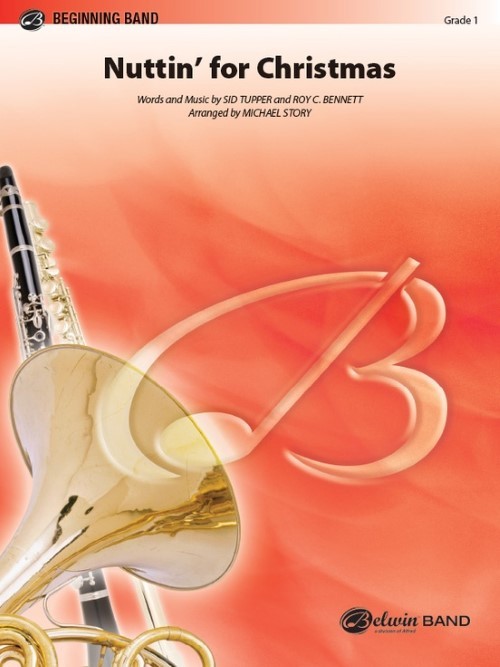Results
-
£62.95
Touch of Christmas, Suite 1, A - Stan Applebaum
New York Pops arranger Stan Applebaum has done it again! This time, he has combined four classic carols in an exciting and musical arrangement with new harmonic twists, playful countermelodies, and lush harmonic settings. Consider this if you're looking to spice up the holidays without the excessive technical demands. Highly recommended.
Estimated delivery 7-14 working days
-
 £59.95
£59.95Blue Jeans (Trombone Solo with Concert Band - Score and Parts)
In 2008 the trombonist, Chris Jeans, was invited to be a featured soloist at a British Trombone Society event. He contacted Stan Kitchen at Studio Music Company to see if he had any new material for trombone. Stan then got in touch with me, as I had already written a piece for another trombone player, Brett Baker. This piece, 'Shout' was programmed for the same event so we needed to find something new for Chris.The title 'Blue Jeans' came to my mind, thus linking a blues-style piece with the obvious reference to Chris's surname. I spoke to Chris and he liked the sound of it so then I had to go away and write a solo to match the title!I managed to get a version with piano accompaniment done in time for Chris to perform at the trombone event and have now had a chance to complete the band version. Chris is a great chap, a good friend and a wonderful trombone player so I hope people enjoy listening to this solo that bears his name.- Rob WiffinDuration: 3.30
Estimated delivery 7-14 working days
-
 £72.99
£72.99Big Band Signatures
Here's a delightful collection of some of the most memorable icons of the fabulous Big Band era. John Higgins' arrangement weaves through great musical memories, each closely identified with a legendary artist and the unique sound of his band. Includes: Peanut Vendor (Stan Kenton), Caravan (Duke Ellington), Woodchopper's Ball (Woody Herman), and Leap Frog (Les Brown).
Estimated delivery 7-14 working days
-
 £57.50
£57.50(Ghost) Riders in the sky - Stan Jones
Master Level (correlates with Book 2, p. 32) The sounds of the old west come alive in this exciting arrangement by Paul Lavender. Effectively scored for all sections, your players will have a blast playing this one!
Estimated delivery 7-14 working days
-
£79.50
Touch of Christmas, Suite 2, A
Bring the magic of New York Pops arranger Stan Applebaum into your own concert hall with this fabulous arrangement! The opening Ukrainian Bell Carol is given a Spanish flavor (with castanets) before moving into the well-known March of the Toys from "Babes in Toyland.
Estimated delivery 7-14 working days
-
 £204.00
£204.00The Music of Antonio Carlos Jobim - Antonio Carlos Jobim
ivind Westby has written a number of excellent but demanding instrumental arrangements for Concert Band. In the present one, he has transcribed five of the most famous by Antonio Carlos Jobim. Brazilian composer Antonio Carlos Jobim (1927-1994) grew up near Ipanema, the famous beach in Rio de Janeiro. His big break through and most creative period came in the 50's and 60's which gave him the status as the greatest Brazilian composer of all times. Together with Stan Getz and Jo�o and Astrud Gilberto he recorded one of the best selling jazz-albums of all times, an album which feature several of his most famous compositions. His inspiration includes another Brazilian great; Pixinguinha, but also classical composers like Frederick Chopin and Claude Debussy. He died in NYC in 1994 after composing approx. 400 works. He is recognized all over the world as one of the most influential composers of the 20th century.
Estimated delivery 7-14 working days
-
 £113.30
£113.30Moderate Dances - Angelo Sormani
This piece is a tribute to dance music, especially passionate, intense and meditative dance music. "Moderate Dances" is divided into three movements: a "Tango", a "Slow Waltz" and a "Bossa Nova". Each movement and each dance has its own particular characteristics but, when combined, these different rhythmic beats and times give the piece a feeling of completeness and uniformity. The Tango started to flourish in the suburbs of Buenos Aires in around 1880. There is still some doubt as to its origins, which may be Cuban (Habanera) but are probably African. It was most popular in Argentina and Brazil: here the male protagonist was originally the "gaucho" with his inseparable guitar, later to be replaced by the proud, elegant "compadre". By around 1910 the Tango had spread to Italy and France. New clubs opened, where the upper classes could watch and dance the Tango. Here the dance also underwent some rapid transformations. The exaggerated and extravagant gestures and body movements disappeared. Slow, gliding steps replaced the old rotational movements. The women's red ankle-boots and the partners "staring into each other's eyes" accentuated the erotic nature and sensuality of this dance. So much so that, in 1913, the German government banned soldiers from dancing the Tango. Those who broke the law were immediately discharged from the army. From a strictly musical perspective, the basic instruments were a flute, a harp (the diatonic harp typically played by the Indians of Paraguay) and a violin, or flute, guitar and violin or even clarinet, guitar and violin. These instruments were easy to transport, ideal for playing at parties, in the streets and in courtyards. The musicians played by ear, frequently improvising: there were no scores, no records, which is the main reason why it is impossible to trace the Tango back to its exact origins. However, the Tango's evolution (and growing popularity) was once again fostered by its fundamental ability to absorb "other" cultures, languages and sounds. And it was the arrival of the "bandoneon" (an accordion-like instrument that was invented in Germany and brought to Rio de la Plata by some immigrant), which replaced the flute, that marked the beginning of the Tango's huge success outside Argentina. A number of talented composers, above all the great Astor Piazzola (1921-1992), transformed the bandoneon from a simple accompanying instrument to a solo instrument that was to become the distinguishing feature of the 20th century Tango. The Slow Waltz originated from the Waltz, the typical dance of the Bavarian and Tyrolese peasants in the 1700s. It was composers like Johann Strauss, father and son, who carried the Waltz to its zenith in the 1800s, creating the sensual and melancholy yet joyful and charming dance we are all familiar with. When the Waltz first became popular in Germany, the members of respectable society were shocked at the closeness of the dancing partners, who had always previously danced apart. The main difference between the Waltz and Slow Waltz is that the latter has a slower, more expressive rhythm: the men wear tails and the women wear ball gowns decorated with beads and feathers and couples dance in graceful rotational movements. "Bossa Nova" is the title of the last movement in the piece. Jobim, the great Brazilian musician, described this musical genre as a combination of modern Jazz and Samba. Bossa Nova means "new wave". This was the name of the artistic and musical movement that evolved in Brazil in the late Fifties and was extremely popular throughout the Sixties. The songs are usually about love or social matters, drawing inspiration from the slums of Rio De Janeiro and the lives of their inhabitants. Bossa Nova, with its original compositions and the artistic talent of its musicians, also became hugely popular in the United States and Europe, and top Jazz musicians (Ella Fitzgerald, Stan Getz, Bob Cooper, Charlie Bird, Sonny Rollins, Dexter Gordon, Dizzy Gillespie) started to include Bossa in their repertoires.
Estimated delivery 7-14 working days
-
 £108.10
£108.10Artistry In Rhythm - Stan Kenton
Estimated delivery 7-14 working days
-
 £49.90
£49.90A Little Bit Bossa (Flexible Ensemble - Score and Parts) - Nyhagen, Bjorn Magne
A Little Bit Bossa is, as the title says, a simple bossa nova with its light and characteristic rhythm. Bossa nova is a Brazilian music genre. It is related to samba and has a strong influence from jazz. The genre attracted many famous artists and became widespread through singers and musicians such as Stan Getz and Astrud Gilberto. Today we find a number of bossa nova songs in jazz's standard repertoire. The parts in this piece are written in a way so that also the youngest and least-experienced musicians can play this piece well.Duration: 1.30
Estimated delivery 7-14 working days
-
 £54.95
£54.95Nuttin' for Christmas (Concert Band - Score and Parts) - Bennett & Tupper - Story, Michael
Made famous by both Art Mooney and His Orchestra and by Stan Freberg, this solidly-scored holiday novelty has been performed and recorded over the years by numerous artists, including Eartha Kitt, Smash Mouth, and The Plain White T's. A classic holiday tune certain to bring smiles!Duration: 2:00
Estimated delivery 7-14 working days
